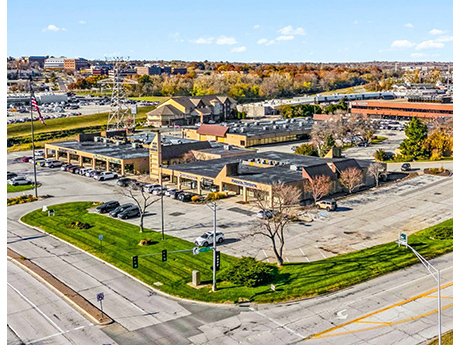By Sam Rolfe, The Lerner Company
It seems Omaha’s retail market shows no signs of slowing down from a position of strength, which received a tangible boost when the metro-area population hit the magic 1 million mark. It’s funny that this population hurdle opens the eyes of retailers so much more than 970,000 would, but there’s no doubt that it does, and the market has reacted accordingly, with year-over-year asking rents up 5.4 percent.
The seemingly rapid growth and development have not vastly affected the city’s historically strong fundamentals and high occupancy rates however, with the vacancy rate in the metro at 4.4 percent. This low vacancy is partially a byproduct of the historically low supply that has plagued the market in recent years.

Over the last decade, we have seen vast westward growth and somewhat stagnant activity in the urban core and central region. Although the westward march continues, it is now coupled with large amounts of urban development, making the city’s retail market strong within eastern submarkets.
The old adage “retail follows rooftops” has held true throughout this growth cycle, as retail developments follow the suburban growth of both homes and apartments. One example of this is at the intersection of 192nd Street and Highway 370 where three of the four corners have large retail developments in progress or slated for construction. Another is the recently announced 500,000-square-foot retail development, Gretna Crossing, from The Lerner Company.
Lockwood has begun a development that will be highlighted by a 125,000-square-foot Nebraska Medicine Health Center, and further progress is being made on Access Commercial’s Gretna Landing, anchored by Hy-Vee’s flagship store.
Grocery-anchored centers have become a darling child in the investment market, and this bullishness is reflected in suburban developments with the aforementioned Hy-Vee and Baker’s planned 123,000-square-foot store on 204th and Q streets, as well as a new location slated for 183rd and Maple streets.
Another West Omaha development, Avenue One, is making use of the Good Life District incentive, which offers tax benefits to developments that bring new-to-market concepts to spur local consumer excitement and create jobs. These developments all hold high expectations of drawing top-tier retailers and shaping the future of the city.
Urban retail activity also follows “rooftops” with new apartment developments. This submarket received fuel from the downtown renaissance highlighted by the new Gene Lahey Mall and Riverfront Park, as well as progress on the streetcar connecting Blackstone and UNMC to downtown. Leasing of retail at streetcar-oriented developments such as 37 West in the Blackstone district have been impressive, considering the asking rents exceed what is traditional in our urban core. In years past, transit-oriented retail has underperformed in a market that’s largely auto-centric, but retailers are making big bets that this isn’t the way of the future.
The only area on the line that still can’t seem to find solid footing is Midtown Crossing, with significant closures like Modern Love and Wholner’s. UNMC’s campus growth can’t be overlooked as a retail driver either, one example being Big Grove Brewery, a part of the 170,000-square-foot Catalyst redevelopment of a former steel factory along Saddle Creek.
Beyond here, construction has finally begun on the long-awaited Crossroads Mall redevelopment, led by Woodbury Corp., a group out of Salt Lake City known for similar projects around the country. Movement on Crossroads, along with the nearly complete Omaha Library, will certainly bring a much-needed boost to what many consider the “main and main” intersection of 72nd and Dodge streets.
Investment activity
Investment deals have seen healthy activity across the board, although most will tell you there are far more buyers looking to add to their portfolio than sellers willing to shop deals. This is partially a result of the interest rate gridlock we’ve seen in recent years, as well as stable, healthy occupancy at attractive rent numbers.
For assets that cashflow well above debt service, and a relative lack of available supply, it’s hard to incentivize owners to let go of trophy assets. However, buyers have found a way at least to some degree, as investment sales volume in the second quarter rose to a higher level than any quarter in the previous year.
Leasing, store closures
An observable trend in the leasing market is a high degree of store closures with near instant backfill of spaces at higher rents, especially in the restaurant sector. Another is longtime, successful urban Omaha classics adding locations on the west side. An example that likely surprised many locals was the addition of Tracks West, considering Tracks has comfortably performed in its Aksarben location for 60+ years without ambition to expand its footprint in the market.
Overall, one thing is for sure, there’s been no lack of news in the retail headlines this year, with new users, developments and announcements popping up on a seemingly daily basis. Although exciting and fast paced, the retail market has retained the classic Omaha value of stable performance that doesn’t prescribe to the rollercoaster booms and earthshattering downturns seen in larger coastal markets. It’s encouraging to see that this has bled into nearly every submarket of the city and not just the bullishness of the west.
Omaha’s retail market is poised to remain full of headlines and executed projects. Many would agree that it’s an exciting time to be a local consumer.
Sam Rolfe is an associate broker with The Lerner Company. This article originally appeared in the October 2025 issue of Heartland Real Estate Business magazine.


